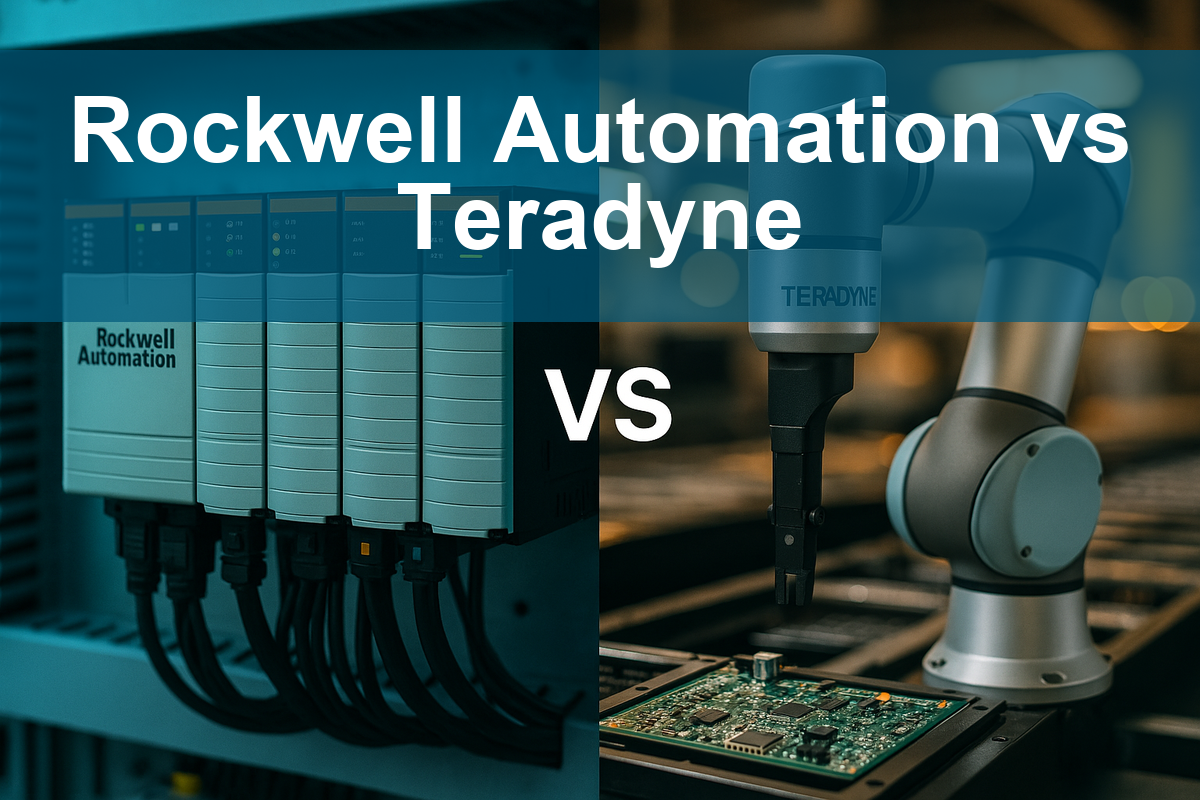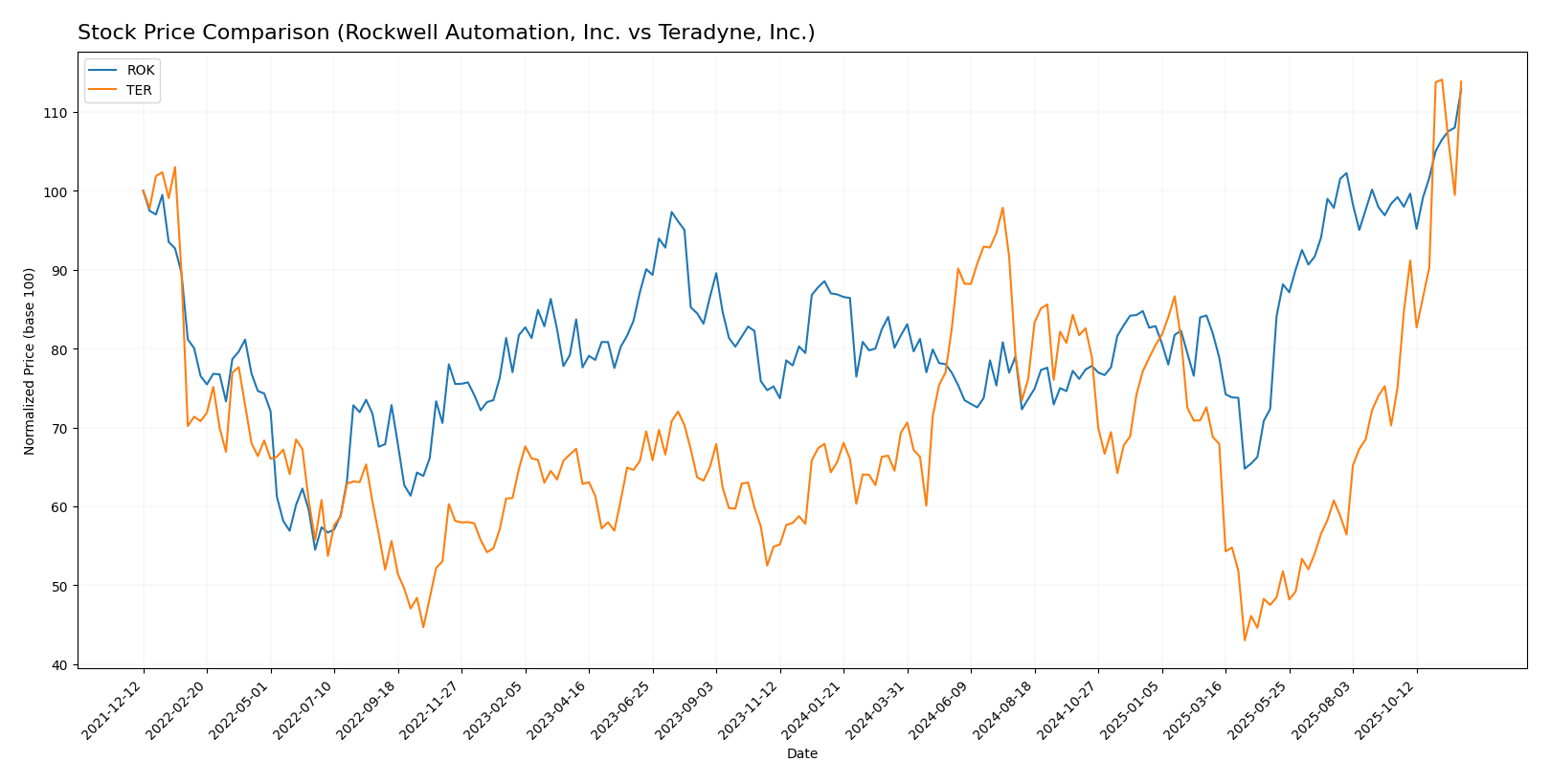In the fast-evolving landscape of industrial automation and semiconductor testing, two companies stand out: Rockwell Automation, Inc. (ROK) and Teradyne, Inc. (TER). Both firms operate within overlapping markets, focusing on innovative solutions that drive efficiency and performance. While Rockwell specializes in industrial automation, Teradyne is a leader in automatic test equipment. As an investor, understanding the strengths and strategies of these companies will be crucial in identifying the more compelling investment opportunity. Let’s dive in and determine which of these two companies deserves a spot in your portfolio.

Table of contents
Company Overview
Rockwell Automation, Inc. Overview
Rockwell Automation, Inc. is a leader in the industrial automation sector, providing a range of digital transformation solutions that enhance operational efficiency. Founded in 1903 and headquartered in Milwaukee, Wisconsin, Rockwell operates through three primary segments: Intelligent Devices, Software & Control, and Lifecycle Services. Its offerings span hardware, software, and consulting services aimed at various industries, including automotive, semiconductor, and renewable energy. With a market cap of approximately $44.4B and a diverse customer base, Rockwell is positioned as a pivotal player in advancing automation technologies.
Teradyne, Inc. Overview
Teradyne, Inc., established in 1960 and based in North Reading, Massachusetts, specializes in automatic test equipment. The company operates through four segments: Semiconductor Test, System Test, Industrial Automation, and Wireless Test. Teradyne’s solutions are integral to manufacturing and testing across various sectors, including automotive and telecommunications. Its market cap stands around $29.2B, and its commitment to innovation in robotic automation and testing technology reinforces its strong position in the semiconductor and electronic manufacturing industries.
Key similarities and differences
Both Rockwell Automation and Teradyne operate at the intersection of technology and industrial applications, focusing on automation solutions. However, Rockwell centers on broader industrial automation across diverse sectors, while Teradyne specializes in testing equipment primarily for semiconductor and wireless technologies. This distinction highlights their respective market niches and operational focuses.
Income Statement Comparison
The following table presents a comparison of the most recent income statements for Rockwell Automation, Inc. (ROK) and Teradyne, Inc. (TER), highlighting key financial metrics.
| Metric | Rockwell Automation, Inc. (ROK) | Teradyne, Inc. (TER) |
|---|---|---|
| Market Cap | 44.45B | 29.22B |
| Revenue | 8.34B | 2.82B |
| EBITDA | 1.40B | 0.73B |
| EBIT | 1.07B | 0.61B |
| Net Income | 0.87B | 0.54B |
| EPS | 7.69 | 3.41 |
| Fiscal Year | 2025 | 2024 |
Interpretation of Income Statement
In the latest fiscal year, Rockwell Automation (ROK) saw a revenue increase to 8.34B, reflecting consistent growth, while Teradyne (TER) reported a revenue of 2.82B, indicating a modest increase. Notably, ROK’s net income slightly declined to 0.87B, suggesting potential margin pressures despite revenue growth. Conversely, TER’s net income at 0.54B exhibits a solid performance, with stable margins. Overall, ROK demonstrates strong revenue generation capacity, yet faces challenges in maintaining profitability, while TER shows resilience in its earnings trajectory. Investors should weigh these factors carefully when considering potential investments.
Financial Ratios Comparison
In this section, I will present a comparative table of the most recent financial ratios for Rockwell Automation, Inc. (ROK) and Teradyne, Inc. (TER). This will help in evaluating their financial health and investment potential.
| Metric | Rockwell Automation (ROK) | Teradyne (TER) |
|---|---|---|
| ROE | 0.39 | 0.19 |
| ROIC | 0.16 | 0.17 |
| P/E | 23.76 | 36.93 |
| P/B | 9.21 | 7.11 |
| Current Ratio | 2.37 | 2.91 |
| Quick Ratio | 1.56 | 1.84 |
| D/E | 0.97 | 0.03 |
| Debt-to-Assets | 0.32 | 0.02 |
| Interest Coverage | 8.37 | 165.54 |
| Asset Turnover | 0.73 | 0.76 |
| Fixed Asset Turnover | 6.89 | 4.88 |
| Payout Ratio | 0.60 | 0.14 |
| Dividend Yield | 1.87% | 0.38% |
Interpretation of Financial Ratios
Analyzing the ratios, Rockwell Automation shows a strong return on equity (ROE) and return on invested capital (ROIC), indicating effective management of shareholder equity. However, its price-to-earnings (P/E) ratio suggests it may be overvalued compared to Teradyne. Teradyne exhibits a significantly lower debt-to-equity (D/E) ratio and outstanding interest coverage, suggesting excellent financial health and low leverage. The payout ratio indicates that Teradyne retains more earnings for growth, while Rockwell has a higher dividend payout, which might appeal to income-focused investors. Overall, both companies have strengths, but their valuation and debt levels present different risk profiles.
Dividend and Shareholder Returns
Rockwell Automation (ROK) pays dividends with a current payout ratio of 59.95%, translating to a dividend yield of 1.87%. The company has demonstrated a stable dividend per share trend, supported by a healthy free cash flow coverage ratio of 1.99. However, investors should remain cautious of potential risks such as unsustainable distributions amidst market fluctuations.
In contrast, Teradyne (TER) does not prioritize dividends, reflecting a reinvestment strategy aimed at growth and innovation. The company maintains a minimal payout ratio of 15.13% and engages in share buybacks, which could enhance shareholder value over the long term. This approach aligns with a focus on sustainable value creation, despite the absence of direct cash returns to shareholders.
Strategic Positioning
Rockwell Automation (ROK) holds a robust position in the industrial machinery sector, with a market cap of $44.4B and a diverse offering across intelligent devices and software solutions. In contrast, Teradyne (TER), valued at $29.2B, excels in the semiconductor testing market. Both companies face competitive pressure from technological advancements and increased automation demands, necessitating ongoing innovation to maintain their market shares. As the landscape evolves, their ability to adapt will be crucial for sustained growth.
Stock Comparison
In analyzing the weekly stock price movements of Rockwell Automation, Inc. (ROK) and Teradyne, Inc. (TER) over the past year, we observe significant upward trends and notable price dynamics that may influence investment decisions.

Trend Analysis
For Rockwell Automation, Inc. (ROK), the stock has experienced a 29.77% increase over the past year, indicating a bullish trend. The highest price reached was 395.86, while the lowest was 227.11, revealing a high level of volatility with a standard deviation of 36.69. The trend shows acceleration with a recent price change of 14.77% from September 14, 2025, to November 30, 2025.
Conversely, Teradyne, Inc. (TER) has demonstrated a remarkable 76.99% increase over the same period, also reflecting a bullish trend. The stock peaked at 182.28 and hit a low of 68.72, resulting in a standard deviation of 24.53, which indicates moderate volatility. The trend is characterized by acceleration, with a recent price change of 62.05% during the same recent timeframe.
Both stocks exhibit strong buyer dominance, suggesting a favorable trading environment for investors looking to capitalize on upward price movements.
Analyst Opinions
Recent analyst recommendations indicate a mixed outlook for Rockwell Automation, Inc. (ROK) and Teradyne, Inc. (TER). For ROK, analysts have issued a “C-” rating, suggesting a cautious stance due to low scores in various financial metrics, indicating potential risks. Conversely, TER holds a “B” rating, with strong performance in return on assets and equity, prompting several analysts to recommend a “buy.” The consensus for ROK leans toward a “sell,” while TER is viewed more positively, with a general “buy” consensus for the current year.
Stock Grades
In the current market landscape, it’s essential to stay informed about stock ratings from reliable sources. Below are the latest stock grades for Rockwell Automation, Inc. (ROK) and Teradyne, Inc. (TER) from recognized grading companies.
Rockwell Automation, Inc. Grades
| Grading Company | Action | New Grade | Date |
|---|---|---|---|
| Baird | Maintain | Outperform | 2025-11-21 |
| B of A Securities | Maintain | Buy | 2025-11-20 |
| JP Morgan | Maintain | Neutral | 2025-11-11 |
| Morgan Stanley | Maintain | Overweight | 2025-11-10 |
| Wells Fargo | Maintain | Equal Weight | 2025-11-07 |
| Barclays | Maintain | Overweight | 2025-11-07 |
| JP Morgan | Maintain | Neutral | 2025-10-15 |
| Oppenheimer | Maintain | Outperform | 2025-10-14 |
| Wells Fargo | Maintain | Equal Weight | 2025-10-06 |
| Barclays | Maintain | Overweight | 2025-08-14 |
Teradyne, Inc. Grades
| Grading Company | Action | New Grade | Date |
|---|---|---|---|
| Citigroup | Maintain | Buy | 2025-11-12 |
| JP Morgan | Maintain | Neutral | 2025-10-30 |
| Goldman Sachs | Maintain | Sell | 2025-10-30 |
| Evercore ISI Group | Maintain | Outperform | 2025-10-30 |
| UBS | Maintain | Buy | 2025-10-30 |
| Stifel | Maintain | Hold | 2025-10-28 |
| Evercore ISI Group | Maintain | Outperform | 2025-10-28 |
| UBS | Maintain | Buy | 2025-10-20 |
| Morgan Stanley | Maintain | Equal Weight | 2025-10-14 |
| Stifel | Maintain | Hold | 2025-10-13 |
Overall, the grades for Rockwell Automation indicate a stable outlook with several maintain actions at solid ratings. Teradyne, while maintaining a mix of buy and sell ratings, shows a slightly more cautious sentiment among analysts, particularly with Goldman Sachs grading it as a sell. Investors should weigh these ratings carefully within their portfolios.
Target Prices
Currently, I have reliable target price data for two companies: Rockwell Automation, Inc. (ROK) and Teradyne, Inc. (TER).
| Company | Target High | Target Low | Consensus |
|---|---|---|---|
| Rockwell Automation, Inc. | 402 | 345 | 377.6 |
| Teradyne, Inc. | 215 | 119 | 172.67 |
For Rockwell Automation, analysts have a consensus target price of 377.6, indicating a slight upside potential from the current price of 395.86. Meanwhile, Teradyne’s consensus target of 172.67 suggests a robust upside from its current price of 181.90. Overall, analysts appear optimistic about both stocks, with expectations of price appreciation in the near term.
Strengths and Weaknesses
The following table outlines the strengths and weaknesses of Rockwell Automation, Inc. (ROK) and Teradyne, Inc. (TER) to help you assess their potential as investment opportunities.
| Criterion | Rockwell Automation (ROK) | Teradyne, Inc. (TER) |
|---|---|---|
| Diversification | Moderate | High |
| Profitability | Strong (Net Profit Margin: 15.26%) | Very Strong (Net Profit Margin: 19.23%) |
| Innovation | Robust (Focus on automation) | Strong (Emphasis on test solutions) |
| Global presence | Extensive | Extensive |
| Market Share | Leading in industrial automation | Leading in semiconductor testing |
| Debt level | Moderate (Debt/Equity: 1.17) | Low (Debt/Equity: 0.03) |
Key takeaways indicate that while both companies have strong profitability and global presence, Teradyne shows a higher level of diversification and significantly lower debt levels, presenting a potentially lower risk investment.
Risk Analysis
The following table outlines the key risks associated with Rockwell Automation, Inc. (ROK) and Teradyne, Inc. (TER).
| Metric | Rockwell Automation, Inc. (ROK) | Teradyne, Inc. (TER) |
|---|---|---|
| Market Risk | Medium | High |
| Regulatory Risk | Medium | Medium |
| Operational Risk | Medium | Low |
| Environmental Risk | Low | Low |
| Geopolitical Risk | High | Medium |
In summary, both companies face significant market and geopolitical risks, particularly ROK, which operates in multiple global markets. Teradyne’s exposure to semiconductor demand fluctuations adds to its market risk.
Which one to choose?
When comparing Rockwell Automation (ROK) and Teradyne (TER), several factors emerge. ROK has a lower overall rating of C-, indicating some challenges in profitability and operational efficiency, reflected in its recent net profit margin of 11.53% and a debt-to-equity ratio of 0.97. In contrast, TER boasts a B rating with a net profit margin of 19.23%, showcasing superior profitability and operational strength alongside a debt-to-equity ratio of just 0.03, which points to better financial stability.
From a stock performance perspective, TER’s price has surged by 76.99% over the past year, outpacing ROK’s 29.77%. Analysts favor TER, citing its strong growth potential and lower risk profile.
Investors focusing on growth may prefer Teradyne for its robust market performance and financial metrics, while those prioritizing stability might consider Rockwell Automation, albeit with caution due to its lower ratings and profitability concerns.
Disclaimer: This article is not financial advice. Each investor is responsible for their own investment decisions.
Go further
I encourage you to read the complete analyses of Rockwell Automation, Inc. and Teradyne, Inc. to enhance your investment decisions:



